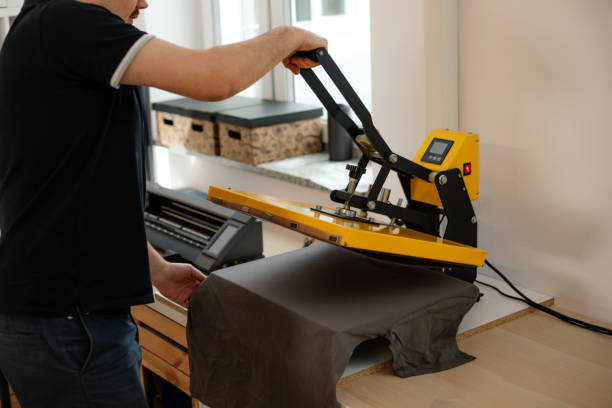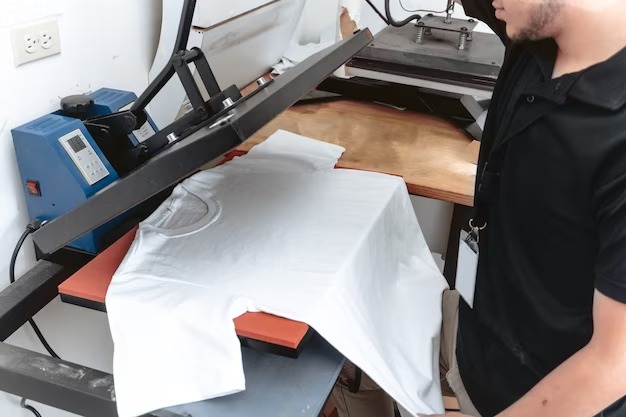HTV (heat transfer vinyl) and heat transfer paper are electronic machines designed for t-shirts and other garments.
Apart from that, people also use this to design pillows, bags, and other fabric items. They both ensure promising advantages to the clothes and may assist you in creating a DIY shirt design.
Even popular brands use them to manufacture their products. Despite all the similarities, they still have a few contrasts that make them different.
In this blog, you’ll learn the differences between HTV and heat transfer paper.
What is HTV?

Known widely as heat transfer vinyl, it’s a revolutionary tool for designing t-shirts and other traditional clothing items and applying HTV to synthetic fabrics, including pillows and bags.
Its versatility extends to various materials, making it a go-to solution for creative fabric designs. They generate a certain amount of heat on the T-shirts. After that, if you apply vinyl roll on it, you can create a fascinating t-shirt for yourself. They are the perfect choice if you have small designs.
In addition to fabrics, you can also use HTV to design polyester clothes. HTV also removes dirt and moisture from your clothes. If you want, you can print your favorite or personalized portrait on your shirt using HTV.
What is Heat Transfer Paper?

Heat transfer paper is a tool that people use to print t-shirt designs. You can connect it with your desktop and printer. It requires the same ink as the printer. They produce an immense heat to design your t-shirts. If your design is long, you should consider using heat transfer paper. It might take a lot of time, but you can create multi-color t-shirts using this tool.
Not only that, you can create several creative and iconic designs with the help of heat transfer paper. You may feel your design after wearing the clothes designed with this tool.
Difference Between HTV and Heat Transfer Paper
1. Resistance
If you design your clothes using the HTV, aka heat transfer vinyl, the clothes might be free from wrinkles. In addition, it ensures the stretchability of your clothes. However, heat transfer paper doesn’t ensure resistance to the new clothes.
Thus, it fails to maintain a stretchability level on the designed clothes. Heat transfer vinyl may remove dirt and moisture from the clothes. Meanwhile, heat transfer paper can’t be able to perform this.
2. Printing Process
Heat transfer paper is used to print an image on your t-shirt. After connecting it with your desktop and printer, you create a unique design for your t-shirt. Meanwhile, heat transfer vinyl is used to design t-shirts. HTV requires a few heat transfer vinyl rolls or cutouts to design your clothes or other fabric items.
Contrarily, heat transfer paper doesn’t need any specific rolls or cutouts. However, both establish a vibrant look to your clothes.
3. Cost Effectiveness
Heat transfer paper may require less ink than the HTV. You can use the same printer ink for heat transfer paper. Apart from that, heat transfer paper can print your design directly. Conversely, heat transfer vinyl requires special vinyl rolls and inks to complete your t-shirt design.
In addition, HTV might also need special cover sheets. Thus, it can be said that heat transfer paper has a lower startup cost than heat transfer vinyl.
4. Designing
You must require vinyl rolls to create a design for your t-shirt, bags, or pillows using HTV. Using the heat transfer paper instead, you don’t require any. The heat transfer vinyl rolls also needed a cutout. You have to use scissors to create a design using the HTV.
Meanwhile, the heat transfer paper doesn’t need any hard work. All you require is a printer and desktop, and it can create your design directly.
5. Heat
Heat transfer vinyl can design a product with a maximum temperature of just 140°C. However, during t-shirt design, try to keep it neutral between 130°C and 135°C. Contrarily, heat transfer paper generates a minimum heat of 171°C to 185°C.
There’s a chance that heat transfer paper can burn your t-shirts. If you use HTV, you’re mitigating the burning chances. So, for a simple design, use HTV, and for a large design, utilize the heat transfer paper.
6. Time Consumption
HTV can help you design your clothes, pillow, or bags at just 140°C. With the help of vinyl rolls and cutouts (if needed), HTV doesn’t consume much time. You need to press HTV 3-4 times to design your cloth, and it will take just 15-20 seconds for one item.
Meanwhile, the heat transfer paper might generate more heat, but it will take at least 30 seconds per item. In addition, you need to think about the time-consuming design.
7. Durability
Wash the printed design before creating your creative t-shirts or bags using heat transfer paper. Wash it at least 25 to 30 times before you put it on your fabric.
Meanwhile, HTV designs don’t require washing. It will automatically print that design on your clothes, bags, or pillows. In addition, the clothes designed by HTV are more durable than those designed by heat transfer paper.
Conclusion
Heat transfer vinyl (HTV) and heat transfer paper are almost used in the same process. However, they have huge differences. You can use heat transfer paper to print a design for your t-shirts, bags, and other fabric items.
Meanwhile, HTV is used to design that fabric item. Heat transfer paper may save you money. Conversely, HTV saves you more time than heat transfer paper since it doesn’t require washing and can design a cloth in just 15 seconds.
You’ve acknowledged the difference between HTV and heat transfer paper in this blog. If you still have any queries, let us know in the comments.

